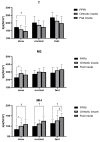Design and Preliminary Validation of Individual Customized Insole for Adults with Flexible Flatfeet Based on the Plantar Pressure Redistribution
- PMID: 33806449
- PMCID: PMC7961547
- DOI: 10.3390/s21051780
Design and Preliminary Validation of Individual Customized Insole for Adults with Flexible Flatfeet Based on the Plantar Pressure Redistribution
Abstract
Flatfoot is a common musculoskeletal deformity. One of the most effective treatments is to wear individually customized plantar pressure-based insoles to help users change the abnormally distributed pressure on the pelma. However, most previous studies were divided only into several plantar areas without detailed plantar characteristic analysis. In this study, a new insole is designed which redistributes pressure following the analysis of characteristic points of plantar pressure, and practical evaluation during walking of subjects while wearing the insole. In total, 10 subjects with flexible flatfeet have participated in the performance of gait experiments by wearing flat insoles, orthotic insoles, and plantar pressure redistribution insoles (PPRI). The results showed that the stance time of PPRI was significantly lower than that of the flat insoles under slow gait. PPRI in the second to third metatarsal and medial heel area showed better unloading capabilities than orthotic insoles. In the metatarsal and heel area, the PPRI also had its advantage in percentage of contact area compared to flat insole and orthotic insole. The results prove that PPRI improves the plantar pressure distribution and gait efficiency of adults with flexible flatfeet, and can be applied into clinical application.
Keywords: 3D modeling; flatfoot; gait; insole; plantar pressure redistribution.
Conflict of interest statement
All authors declare no conflict of interest.
Figures





References
-
- Han J.T., Koo H.M., Jung J.M., Kim Y.J., Lee J.H. Differences in Plantar Foot Pressure and COP between Flat and Normal Feet during Walking. J. Phys. Ther. Sci. 2011;23:683–685. doi: 10.1589/jpts.23.683. - DOI
MeSH terms
Grants and funding
LinkOut - more resources
Full Text Sources
Other Literature Sources
Medical

